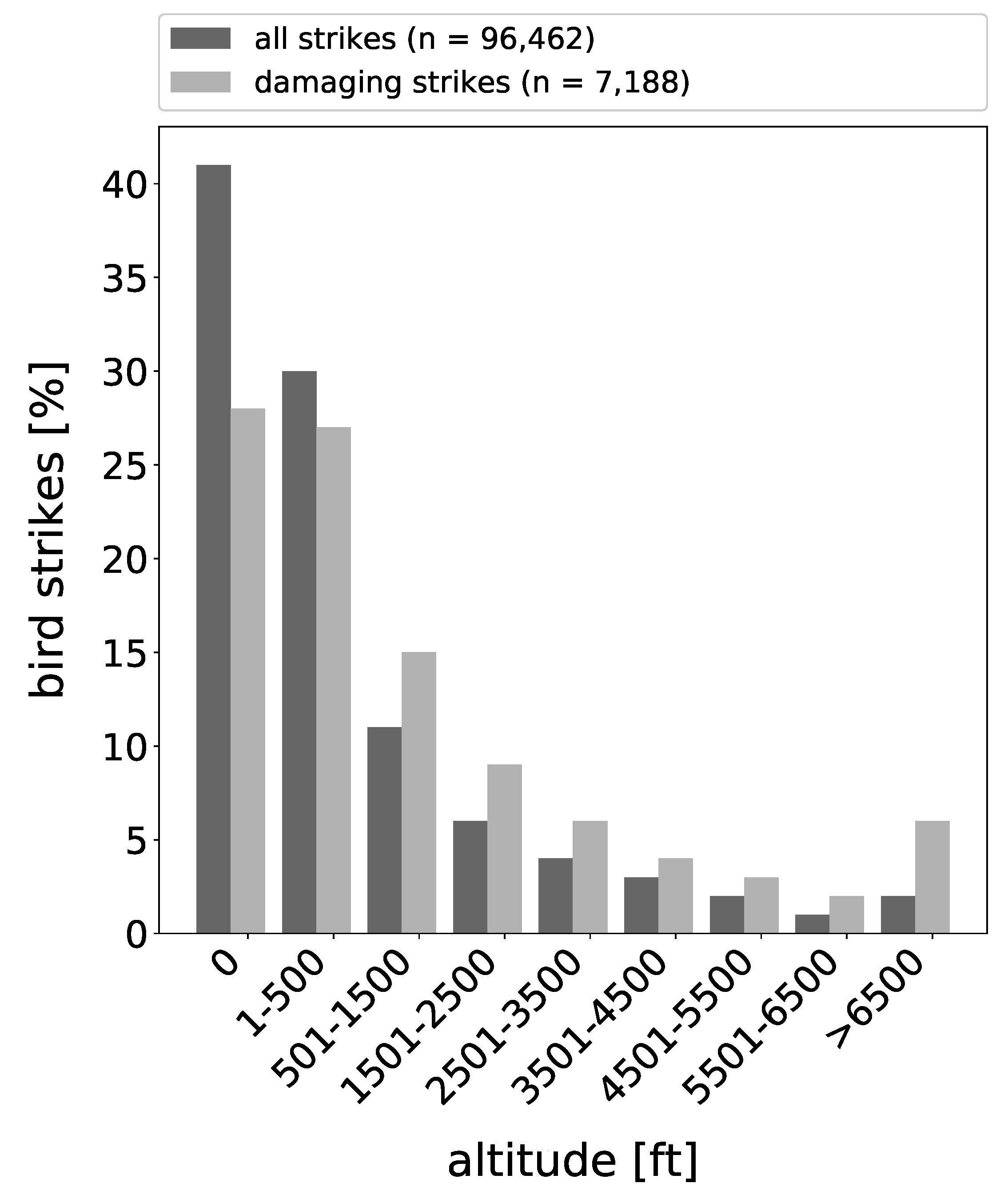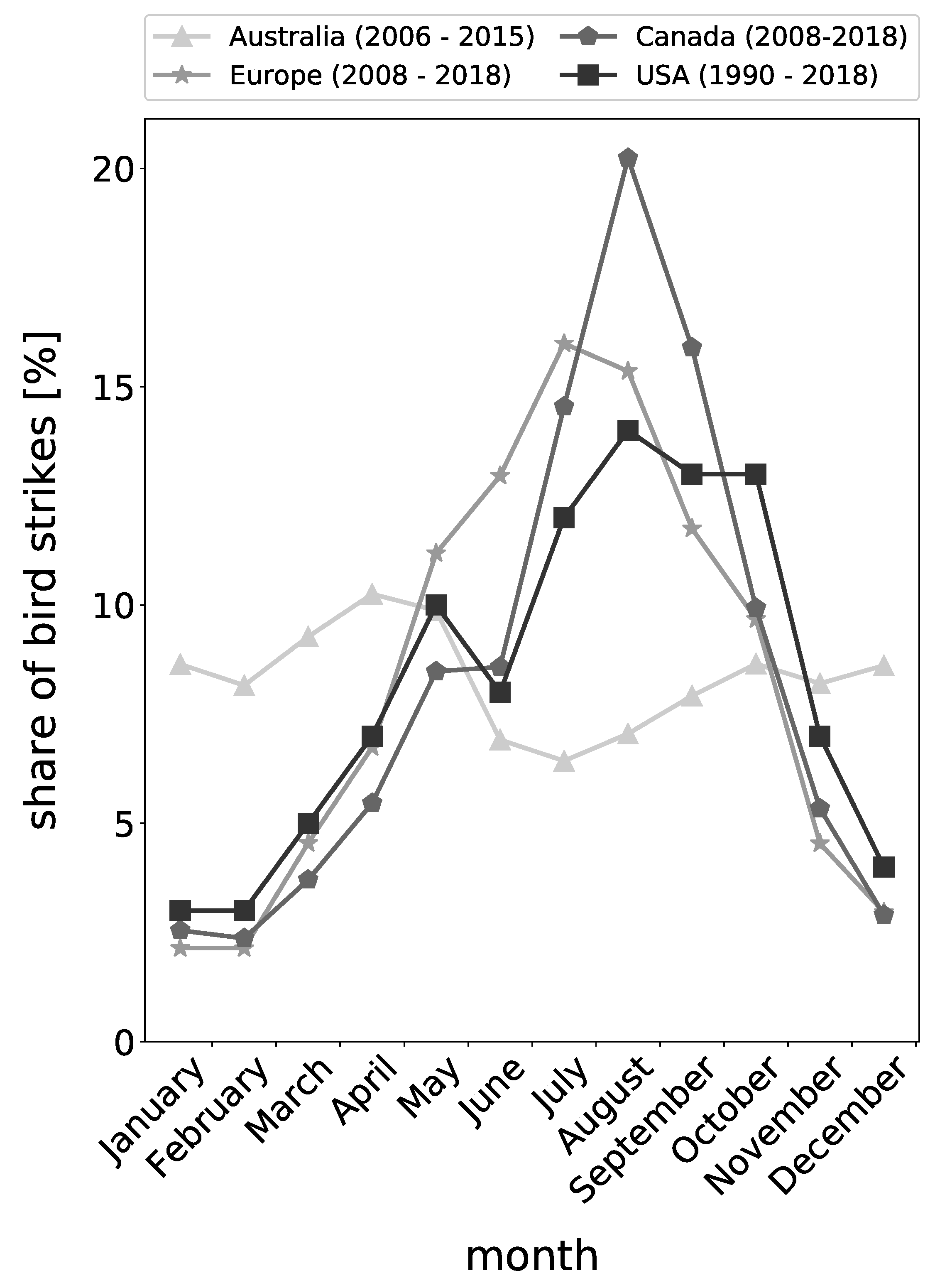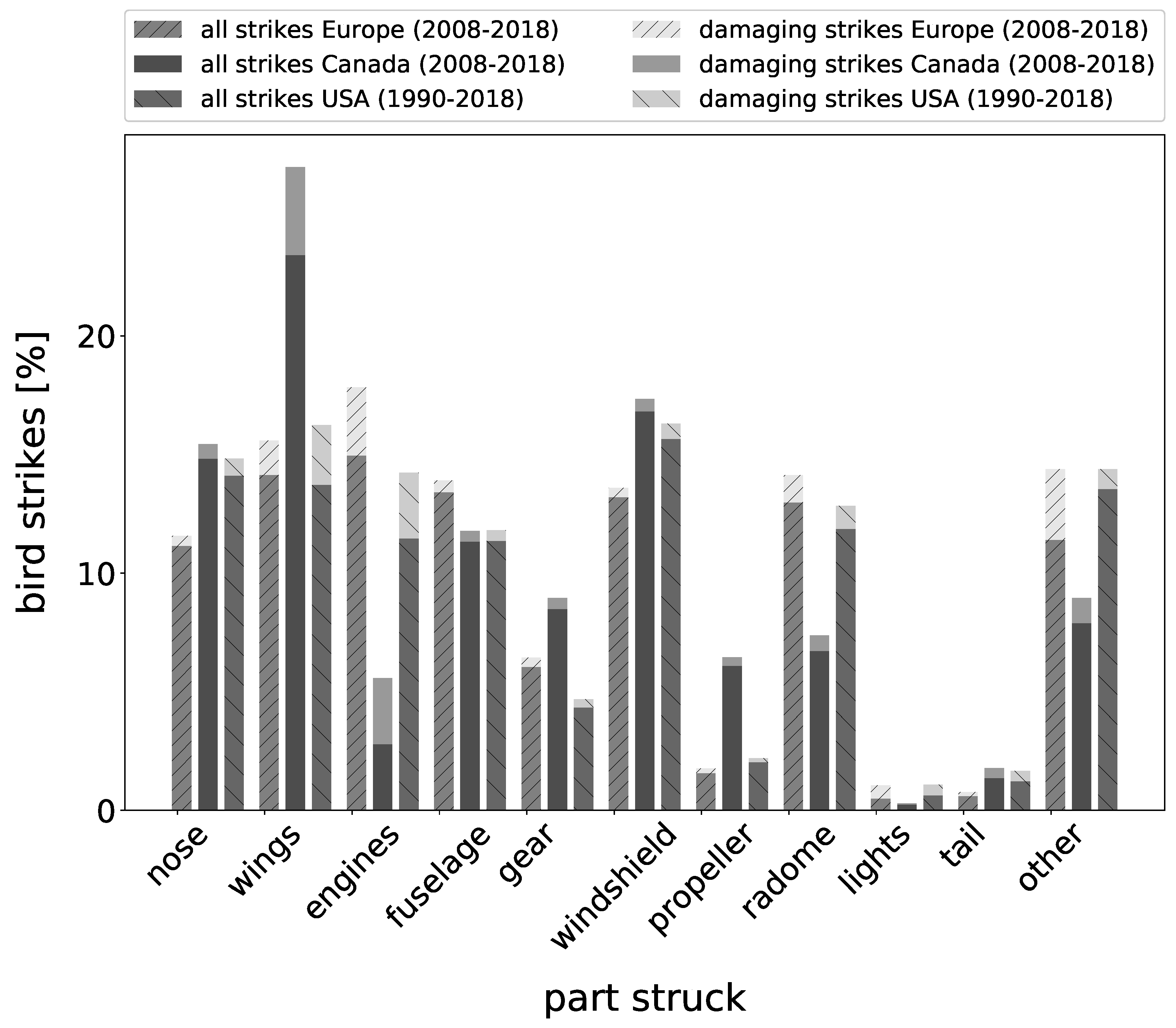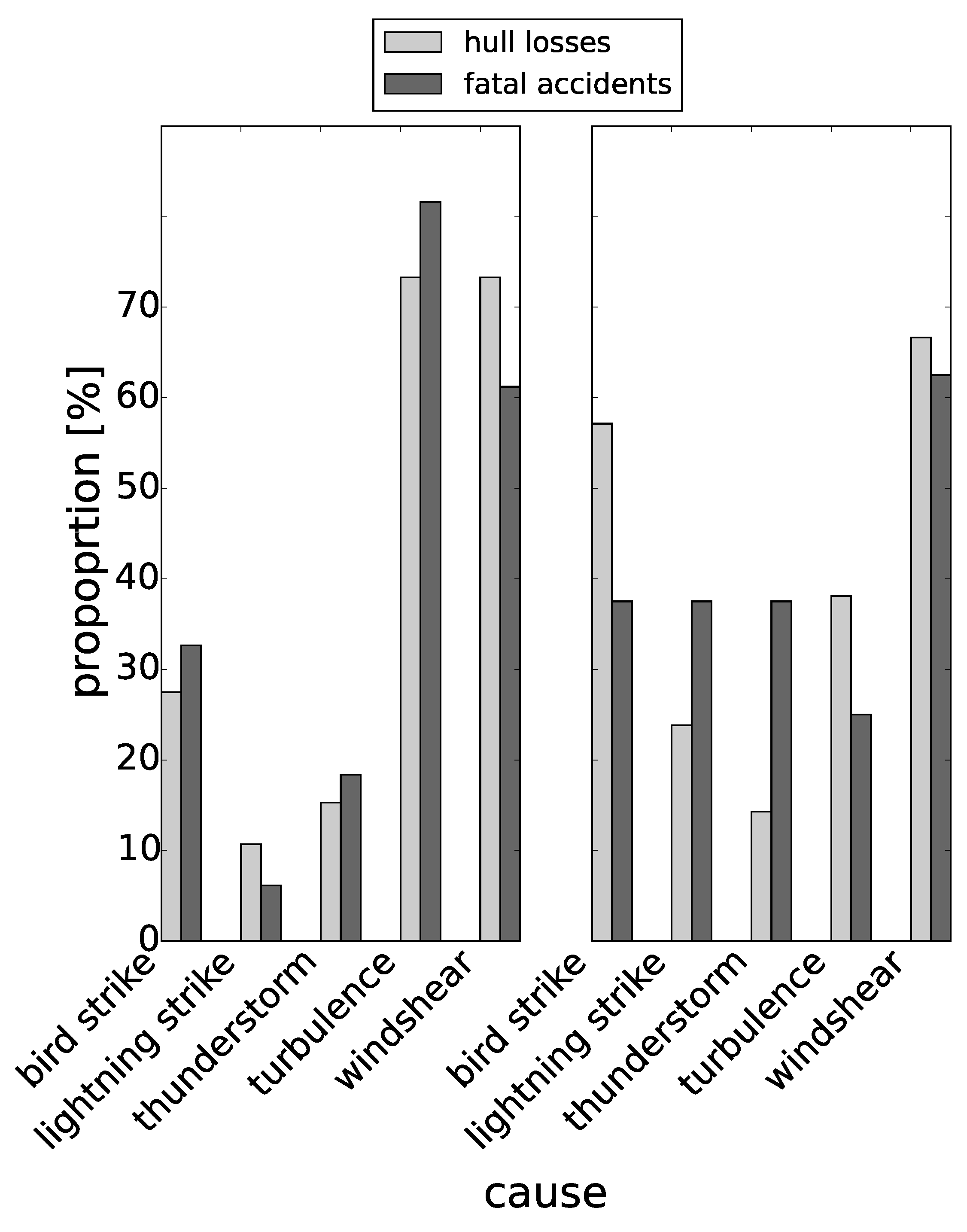The Bird Strike Challenge
Abstract
1. Introduction
2. Definitions and Data Availability
3. The Probability of Bird Strikes
3.1. Altitude
3.2. Season
3.3. Location and Environmental Conditions
3.4. Aircraft Characteristics
4. The Severity of Bird Strikes
4.1. Parts Struck
4.2. Risk of Accidents
4.3. Effect on Flight
4.4. Costs of Bird Strikes
5. The Counteracting Measures
5.1. Mitigation Measures on the Ground
5.2. Aircraft-Related Mitigation Measures
5.3. Regulatory Mitigation Measures
5.3.1. Certification Requirements
- Windshield: withstand without penetration an impact of a 2 lb bird at cruise speed.
- Structure: Successfully completing a flight after an impact with a 4 lb bird when the aircraft’s velocity relative to the bird along the aircraft’s flight path equals cruise speed at sea level or 0.85 cruise speed at 8000 ft, whichever is more critical.
- Empennage: Successfully completing a flight after an impact with an 8 lb bird at cruise speed (FAA only).
- Pitot tubes: sufficient separation to prevent damage to all of them in case of a bird strike.
- i.
- non-containment of high-energy debris,
- ii.
- concentration of toxic products in the engine bleed air for the cabin sufficient to incapacitate crew or passengers,
- iii.
- significant thrust in the opposite direction to that commanded by the pilot,
- iv.
- uncontrolled fire,
- v.
- failure of the engine mount system leading to inadvertent engine separation,
- vi.
- release of the propeller by the Engine, if applicable,
- vii.
- complete inability to shut the engine down.
5.3.2. Speed Limitations
6. The Next Step
7. Conclusions
Author Contributions
Funding
Acknowledgments
Conflicts of Interest
References
- Avisure. Fatalities and Destroyed Aircraft in Aviation. 2019. Available online: https://avisure.com/about-us/fatalities-and-destroyed-aircraft-due-to-wildlife-strikes-1912-to-present/ (accessed on 30 January 2020).
- Australian Transport Safety Bureau. Australian Aviation Wildlife Strike Statistics 2008 to 2017; Australian Transport Safety Bureau: Canberra, Australia, 2019.
- Harris, D.; (Transport Canada, Ottawa, ON, Canada). Personal communication, 26 July 2019.
- Direction Générale de l’Aviation Civile. Analyse du Risque Animalier en France 2010–2013. 2017. Available online: https://de.calameo.com/read/000687261c8f500e036b0 (accessed on 20 February 2020).
- Deutscher Ausschuss zur Verhütung von Vogelschlägen im Luftverkehr e.V. Jahresbericht 2018; DAVVL: Bremen, Germany, 2019. [Google Scholar]
- UK Civil Aviation Authority. Birdstrikes. Available online: https://www.caa.co.uk/Commercial-Industry/Airports/Safety/Birdstrikes/ (accessed on 5 February 2020).
- Dolbeer, R.A.; Cleary, E.C.; Wright, S.E. Wildlife Strikes to Civil Aircraft in the United States 1990–2018; Federal Aviation Administration National Wildlife Strike Database, Serial Report Number 25; Federal Aviation Administration, U.S. Department of Agriculture: Washington, DC, USA, 2019.
- Luftfahrtbundesamt. European Central Repository According to Regulation (EU) No. 376/2014 of the European Parliament and of the Council; Luftfahrtbundesamt: Brunswick, Germany, 2019. [Google Scholar]
- Australian Transport Safety Bureau. Australian Aviation Wildlife Strike Statistics 2006 to 2015; Australian Transport Safety Bureau: Canberra, Australia, 2017.
- Canada, T. Bird Strike Information System. 2019. Available online: https://wwwapps.tc.gc.ca/Saf-Sec-Sur/2/bsis/ (accessed on 26 July 2019).
- Allan, J.R. The costs of bird strikes and bird strike prevention. In Human Conflicts with Wildlife: Economic Considerations; DigitalCommons@University of Nebraska–Lincoln: Lincoln, NE, USA, 2000; Available online: https://digitalcommons.unl.edu/cgi/viewcontent.cgi?article=1017&context=nwrchumanconflicts (accessed on 12 February 2020).
- UK Civil Aviation Authority. CAA Paper 2006/05: The Completeness and Accuracy of Birdstrike Reporting in the UK; CAA Report; UK Civil Aviation Authority: London, UK, 2006.
- Dolbeer, R.A. Trends in Reporting of Wildlife Strikes with Civil Aircraft and in Identification of Species Struck Under a Primarily Voluntary Reporting System, 1990–2013; Special Report Submitted to the Federal Aviation Administration; DigitalCommons@University of Nebraska–Lincoln: Lincoln, NE, USA, 2015; Available online: https://digitalcommons.unl.edu/cgi/viewcontent.cgi?article=1190&context=zoonoticspub (accessed on 12 February 2020).
- Dolbeer, R.A.; Weller, J.R.; Anderson, A.L.; Begier, M.J. Wildlife Strikes to Civil Aircraft in the United States 1990–2015; Federal Aviation Administration National Wildlife Strike Database, Serial Report Number 22; Federal Aviation Administration, U.S. Department of Agriculture: Washington, DC, USA, 2016.
- Pitlik, T.J.; Washburn, B.E. Using bird strike information to direct effective management actions within airport environments. In Proceedings of the 25th Vertebrate Pest Conference, Monterey, CA, USA, 5–8 March 2012. [Google Scholar]
- European Organization for the Safety of Air Navigation. Bird Strike. 2019. Available online: http://www.skybrary.aero/index.php/Bird_Strike (accessed on 12 February 2020).
- DeVault, T.L.; Kubel, J.E.; Glista, D.J.; Rhodes, O.E., Jr. Mammalian hazards at small airports in Indiana: Impact of perimeter fencing. Hum. Wildl. Conflicts 2008, 2, 240–247. [Google Scholar]
- ICAO. Doc-9332-AN/909—Manual on the ICAO Bird Strike Information System (IBIS), 3rd ed.; ICAO: Montreal, QC, Canada, 1989. [Google Scholar]
- European Parliament and the Council. Regulation (EU) No. 376/2014 of The European Parliament and of The Council of 3 April 2014. Off. J. Eur. Union 2014. Available online: https://eur-lex.europa.eu/legal-content/EN/TXT/PDF/?uri=CELEX:32014R0376&from=EN (accessed on 12 February 2020).
- European Parliament and the Council. Commission implementing regulation EU 2015/1018. Off. J. Eur. Union 2015. Available online: https://eur-lex.europa.eu/legal-content/EN/TXT/PDF/?uri=CELEX:32015R1018&from=EN (accessed on 12 February 2020).
- Air Navigation (Amendment) (No. 2) Ordedr 2003. SI 2003 No. 2905; 2003. Available online: http://www.legislation.gov.uk/uksi/2003/2905/made (accessed on 5 February 2020).
- Allan, J.; Baxter, A.; Callaby, R. The impact of variation in reporting practices on the validity of recommended birdstrike risk assessment processes for aerodromes. J. Air Transp. Manag. 2016, 57, 101–106. [Google Scholar] [CrossRef][Green Version]
- Dolbeer, R.A. Protecting the Flying Public and Minimizing Economic Losses within the Aviation Industry: Technical and Direct Management Assistance provided by USDA Wildlife Services at Airports to reduce Wildlife Hazards Fiscal Year 2008; USDA National Wildlife Research Center: Fort Collins, CO, USA, 2009; p. 14.
- Atkins Ltd.; Food and Environment Research Agency (FERA). Bird Strike Damage & Windshield Bird Strike. 2009. Available online: http://www.easa.europa.eu/rulemaking/docs/research/FinalreportBirdStrikeStudy.pdf (accessed on 13 February 2020).
- ICAO. 2016–2030 Global Air Navigation Plan, 5th ed.; Doc 9750-AN/963; ICAO: Montreal, QC, Canada, 2016. [Google Scholar]
- ICAO. Safety Management, 1st ed.; Annex 19 to the Convention on International Civil Aviation; ICAO: Montreal, QC, Canada, 2013. [Google Scholar]
- MacKinnon, B. Sharing the Skies. An Aviation Industry Guide to the Management of Wildlife Hazards; Transport Canada: Ottawa, ON, Canada, 2004.
- McKee, J.; Shaw, P.; Dekker, A.; Patrick, K. Approaches to Wildlife Management in Aviation. In Problematic Wildlife: A Cross-Disciplinary Approach; Angelici, F.M., Ed.; Springer: Cham, Switzerland, 2016; Chapter 22; pp. 465–488. [Google Scholar]
- Dolbeer, R.A.; Wright, S.; Weller, J.R.; Anderson, A.L.; Begier, M.J. Wildlife Strikes to Civil Aircraft in the United States 1990–2014; Serial Report Number 16; Federal Aviation Administration, U.S. Department of Agriculture: Washington, DC, USA, 2015.
- EASA. Bird Population Trends and Their Impact on Aviation Safety 1999–2008; Safety Report; EASA: Cologne, Germany, 2009. [Google Scholar]
- ICAO. 2008–2015 Wildlife Strike Analyses (IBIS); Electronic Bulletin; ICAO: Montreal, QC, Canada, 2017. [Google Scholar]
- Dolbeer, R.A. Increasing Trend of damaging bird strikes with aircraft outside the airport boundary: Implications for mitigation measures. Hum. Wildl. Interact. 2011, 5, 1235–1248. [Google Scholar]
- van Gasteren, H.; Holleman, I.; Bouten, W.; van Loon, E.; Shamoun-Baranes, J. Extracting bird migration information from C-band Doppler weather radars. Ibis 2008, 150, 674–686. [Google Scholar] [CrossRef]
- Ebert, J. Bird Strikes in the German Civil Aviation 2011 to 2015. Vogel und Luftverkehr Online. 2016. Available online: http://www.davvl.de/sites/default/files/2018-06/2016_ebert_vogelschlaege_deutschen_zivilluftfahrt_11bis15.pdf (accessed on 13 February 2020).
- van Gasteren, H.; Both, I.; Shamoun-Baranes, J.; Laloë, J.O.; Bouten, W. GPS logger onderzoek aan Buizerds helpt vogelaanvaringen op militaire vliegvelden te voorkomen. Limosa 2014, 87, 107–116. [Google Scholar]
- Dekker, A.; van Gasteren, H. EURBASE: Military bird strike frequency in Europe. In Proceedings of the International Bird Strike Committee Conference, Athens, Greece, 23–27 May 2005. [Google Scholar]
- van Gasteren, H.; Krijgsveld, K.L.; Klauke, N.; Leshem, Y.; Metz, I.C.; Skakuj, M.; Sorbi, S.; Schekler, I.; Shamoun-Baranes, J. Aeroecology meets aviation safety: Early warning systems in Europe and the Middle East prevent collisions between birds and aircraft. Ecography 2018, 42. [Google Scholar] [CrossRef]
- Pfeiffer, M.B.; Kougher, J.D.; DeVault, T.L. Civil airports from a landscape perspective: A multi-scale approach with implications for reducing bird strikes. Landsc. Urban Plan. 2018, 179, 38–45. [Google Scholar] [CrossRef]
- Cleary, E.; Dolbeer, R.A.; Wright, S. Wildlife Strikes to Civil Aircraft in the United States 1990–2002; Federal Aviation Administration, U.S. Department of Agricultur: Washington, DC, USA, 2003.
- Dolbeer, R.A. Height Distribution of Birds Recorded by Collisions with Civil Aircraft. J. Wildl. Manag. 2006, 70, 1345–1350. [Google Scholar] [CrossRef]
- Alerstam, T. Bird Migration; Cambridge University Press: Cambridge, UK, 1993. [Google Scholar]
- Dolbeer, R.A. Wildlife Strikes to Civil Aircraft in the United States 1990–2016; Federal Aviation Administration National Wildlife Strike Database, Serial Report Number 23; Federal Aviation Administration, U.S. Department of Agriculture: Washington, DC, USA, 2018.
- ICAO. Aerodromes, 3rd ed.; Annex 14 to the Convention on International Civil Aviation; ICAO: Montreal, QC, Canada, 2004; Volume I. [Google Scholar]
- ICAO. Doc 9137—Airport Services Manual—Part 3—Wildlife Control and Reduction, 5th ed.; ICAO: Montreal, QC, Canada, 2012. [Google Scholar]
- Australian Transport Safety Bureau. Australian Aviation Wildlife Strike Statistics 2004 to 2013; Australian Transport Safety Bureau: Canberra, Australia, 2014.
- DeVault, T.L.; Blackwell, B.F.; Seamans, T.W.; Lima, S.L.; Fernández-Juricic, E. Speed kills: Ineffective avian escape responses to oncoming vehicles. Proc. R. Soc. B 2015, 282, 2014–2188. [Google Scholar] [CrossRef]
- Hall, C.A.; Crichton, D. Engine and Installation Configurations for a Silent Aircraft. In Proceedings of the 17th International Symposium on Airbreathing Engines, Munich, Germany, 4–9 September 2005. [Google Scholar]
- World Airliner Census 2006; FlightGlobal: Sutton, UK, 2006.
- Morrison, M.; Fafard, A. World Airliner Census 2015; FlightGlobal: Sutton, UK, 2015. [Google Scholar]
- Sodhi, N.S. Perspectives in ornithology: Competition in the air: Birds versus aircraft. Auk 2002, 119, 587–595. [Google Scholar] [CrossRef]
- DeFusco, R.P.; Unangst, E.T.J.; Cooley, T.R.; Landry, J.M. ACRP Report 145 Applying an SMS Approach to Wildlife Hazard Management; Airport Cooperative Research Program; Transportation Research Board: Washington DC, USA, 2015. [Google Scholar]
- DeVault, T.L.; Reinhart, B.D.; Brisbin, I.L., Jr.; Rhodes, O.E., Jr. Flight behavior of black and turkey vultures: Implications for reducing bird–aircraft collisions. J. Wildl. Manag. 2005, 69, 601–608. [Google Scholar] [CrossRef]
- Lensink, R.; Kwak, R. Vogeltrek over Arnhem in 1983 Met een Samenvatting over de Periode 1981–1983 en Methodieken voor het bewerken van Telmateriaal; LWVT: Arnhem, The Netherlands, 1985; deel I en II. [Google Scholar]
- Thorpe, J. 100 Years of Fatalities and Destroyed Civil Aircraft due to Bird Strikes. In Proceedings of the 30th Meeting of the International Bird Strike Committee, Stavanger, Norway, 25–29 June 2012. [Google Scholar]
- Thorpe, J. Update to ’100 Years of Fatalities and Destroyed Civil Aircraft due to Bird Strikes’. In Proceedings of the 31th Meeting of the World Bird Strike Association, Atlanta, GA, USA, 30–31 July 2014. [Google Scholar]
- Dolbeer, R.A. Feathers in the fan. AeroSafety World 2008, 3, 22–26. [Google Scholar]
- National Transportation Safety Board NTSB. Loss of Thrust in Both Engines After Encountering a Flock of Birds and Subsequent Ditching on the Hudson River; US Airways Flight 1549, Airbus A320-214, N106US, Weehawken, New Jersey, January 15, 2009, Accident Report NTSB/AAR-10/03 PB2010-910403; National Transportation Safety Board NTSB: Washington, DC, USA, 2010.
- Herald, A. Accident: Ural A321 at Moscow on Aug 15th 2019, Bird Strike into Both Engines Forces Landing in Corn Field. 2019. Available online: http://avherald.com/h?article=4cb94927&opt=0 (accessed on 4 February 2020).
- Barnstorff, K. Wind Shear Accident Was Catalyst for Technology. 2010. Available online: https://www.nasa.gov/topics/aeronautics/features/microburst-windshear.html (accessed on 3 October 2018).
- Ranter, H. ASN Aviation Safety Database. 2018. Available online: https://aviation-safety.net/database/ (accessed on 3 October 2018).
- Federal Aviation Administration. 14 CFR 91.7—Civil Aircraft Airworthiness; Federal Aviation Administration: Washington, DC, USA, 2011.
- Navin, J.; Weiler, S.; Anderson, A. Wildlife strike cost revelation in the US domestic airline industry. Transp. Res. Part D Transp. Environ. 2020, 78, 102204. [Google Scholar] [CrossRef]
- Allan, J.; Orosz, A.; Badham, A.; Bell, J. The Development of Birdstrike Risk Assessment Procedures, Their Use on Airports, and the Potential Benefits to the Aviation Industry. In Proceedings of the International Bird Strike Committee IBSC26/WP-OS7, Warsaw, Poland, 5–9 May 2003. [Google Scholar]
- DeVault, T.L.; Belant, J.L.; Blackwell, B.F.; Seamans, T.W. Interspecific variation in wildlife hazards to aircraft: Implications for airport wildlife management. Wildl. Soc. Bull. 2011, 35, 394–402. [Google Scholar] [CrossRef]
- Belant, J.L.; Washburn, B.E.; DeVault, T.L. Understanding Animal Movements at and near Airports. In Wildlife in Airport Environments: Preventing Animal–Aircraft Collisions Through Science-Based Management; John Hopkins University Press: Baltimore, MD, USA, 2013; p. 129. [Google Scholar]
- Anderson, A.; Carpenter, D.S.; Begier, M.J.; Blackwell, B.F.; DeVault, T.L.; Shwiff, S.A. Modeling the cost of bird strikes to US civil aircraft. Transp. Res. Part D Transp. Environ. 2015, 38, 49–58. [Google Scholar] [CrossRef]
- Schiphol Amsterdam Airport. Bird Control at Schiphol; Schiphol Amsterdam Airport: Schiphol, The Netherlands, 2012. [Google Scholar]
- Belant, J.L.; Martin, J.A. Bird Harassment, Repellent, and Deterrent Techniques for Use on and Near Airports; Airport Cooperative Research Program; Transportation Research Board: Washington, DC, USA, 2011; Volume 23. [Google Scholar]
- Pullins, C.K.; Guerrant, T.L.; Beckerman, S.F.; Washburn, B.E. Mitigation translocation of red-tailed hawks to reduce raptor–aircraft collisions. J. Wildl. Manag. 2018, 82, 123–129. [Google Scholar] [CrossRef]
- Dolbeer, R.A.; Franklin, A.B. Population management to reduce the risk of wildlife-aircraft collisions. In Wildlife in Airport Environments: Preventing Animal-Aircraft Collisions through Science-Based Management; John Hopkins University Press: Baltimore, MD, USA, 2013; pp. 67–78. [Google Scholar]
- Rey, L.; Liechti, F. Overview of the Aims and the Extent of Birdstrike Prevention by Lethal Control on International Airports A literature review on behalf of the Federal Office of Civil Aviation (FOCA); Swiss Ornithological Institute: Sempbach, Switzerland, 2015. [Google Scholar]
- Bernhardt, G.E.; Blackwell, B.F.; DeVault, T.L.; Kutschbach-Brohl, L. Fatal injuries to birds from collisions with aircraft reveal anti-predator behaviors. Ibis 2010, 152, 830–834. [Google Scholar] [CrossRef]
- Blackwell, B.F.; Fernandez-Juricic, E.; Seamans, T.W.; Dolan, T. Avian visual system configuration and behavioral response to object approach. Anim. Behav. 2009, 77, 673–684. [Google Scholar] [CrossRef]
- Blackwell, B.F.; DeVault, T.L.; Seamans, T.W.; Lima, S.L.; Baumhardt, P.; Fernández-Juricic, E. Exploiting avian vision with aircraft lighting to reduce bird strikes. J. Appl. Ecol. 2012, 49, 758–766. [Google Scholar] [CrossRef]
- Fernández-Juricic, E.; Gaffney, J.; Blackwelll, B.F.; Baumhardt, P. Bird strikes and aircraft fuselage color: A correlational study. Hum. Wildl. Interact. 2011, 5, 224–234. [Google Scholar]
- Sheridan, E.; Randolet, J.; DeVault, T.L.; Seamans, T.W.; Blackwell, B.F.; Fernández-Juricic, E. The effects of radar on avian behavior: Implications for wildlife management at airports. Appl. Anim. Behav. Sci. 2015, 171, 241–252. [Google Scholar] [CrossRef]
- Goller, B.; Blackwell, B.F.; DeVault, T.L.; Baumhardt, P.E.; Fernández-Juricic, E. Assessing bird avoidance of high-contrast lights using a choice test approach: Implications for reducing human-induced avian mortality. PeerJ 2018, 6, e5404. [Google Scholar] [CrossRef] [PubMed]
- DeVault, T.; Seamans, T.; Blackwell, B.F.; Lima, S.; Martinez, M.; Fernández-Juricic, E. Can experience reduce collisions between birds and vehicles? J. Zool. 2017, 301, 17–22. [Google Scholar] [CrossRef]
- Lima, S.L.; Blackwell, B.F.; DeVault, T.L.; Fernández-Juricic, E. Animal reactions to oncoming vehicles: A conceptual review. Biol. Rev. 2015, 90, 60–76. [Google Scholar] [CrossRef]
- Welsh, K.W.; Vaughan, J.A.; Rasmussen, P.G. Conspicuity Assessment of Selected Propeller and Tail Rotor Paint Schemes; Document FAA-AM-78-29; Civil Aeromedical Institute Federal Aviation Administration: Oklahoma City, OK, USA, 1978.
- Aas, C.K.; Johansen, B. Conspicuous Pied Propellers—What are the latest Results? In Proceedings of the Bird/Wildlife Strike Prevention Conference, Amsterdam, The Netherlands, 5–9 December 2016. [Google Scholar]
- Blackwell, B.F.; Bernhardt, G.E. Efficacy of aircraft landing lights in stimulating avoidance behavior in birds. J. Wildl. Manag. 2004, 68, 725–732. [Google Scholar] [CrossRef]
- Blackwell, B.F.; DeVault, T.L.; Fernández-Juricic, E.; Gese, E.M.; Gilbert-Norton, L.; Breck, S.W. No single solution: Application of behavioral principles in mitigating human–wildlife conflict. Anim. Behav. 2016, 120, 245–254. [Google Scholar] [CrossRef]
- Precise Flight. The Bird Strike Story. 2018. Available online: https://www.preciseflight.com/aviation-birdstrikes-solutions/ (accessed on 28 December 2019).
- Qantas Airlines and Precise Flight. Precise Flight Pulselite System B737 Operational Evaluation; Evaluating the Operational Use of the Pulselite Landing Light System in the Australasian Airline Environment; Evaluation Period Jan 2005 to Aug 2007; Qantas Airlines and Precise Flight: Bend, OR, USA, n.d.
- European Coordination Centre for Accident and Incident Reporting Systems ECCAIRS, Title = Data Definition Standard. Attribute Values. Available online: https://www.icao.int/safety/airnavigation/AIG/Documents/ADREP%20Taxonomy/ECCAIRS%20Aviation%201.3.0.12%20%28VL%20for%20AttrID%20%20390%20-%20Events%29.pdf (accessed on 20 February 2020).
- ICAO. Airworthiness of Aircraft, 11th ed.; Annex 8 to the Convention on International Civil Aviation; ICAO: Montreal, QC, Canada, 2010. [Google Scholar]
- European Aviation Safety Agency. Certification Specifications and Acceptable Means of Compliance for Large Aeroplanes CS-25; Amendment 23; European Aviation Safety Agency: Cologne, Germany, 2019. [Google Scholar]
- Federal Aviation Administration. 14 CFR Part 25—Airworthiness Standards: Normal Category Airplanes; Federal Aviation Administration: Washington, DC, USA, 2011.
- European Aviation Safety Agency. Certification Specifications for Normal Aeroplanes; Ammendment 5; European Aviation Safety Agency: Cologne, Germany, 2017. [Google Scholar]
- European Aviation Safety Agency. Definitions and Abbreviations Used in Certification Specifications for Products, Parts and Appliances; European Aviation Safety Agency: Cologne, Germany, 2007. [Google Scholar]
- Federal Aviation Administration. Transport Airplanes. Available online: https://www.faa.gov/aircraft/air_cert/design_approvals/transport/ (accessed on 30 September 2019).
- European Aviation Safety Agency. Certification Specifications for Engines; Amendment 3; European Aviation Safety Agency: Cologne, Germany, 2010. [Google Scholar]
- Federal Aviation Administration. 14 CFR 33.76—Bird Ingestion; Federal Aviation Administration: Washington, DC, USA, 2011; Volume 1.
- Thorpe, J. Conflict of Wings: Birds Versus Aircraft. In Problematic Wildlife. A Cross-Disciplinary Approach; Angelici, F.M., Ed.; Springer: Cham, Switzerland, 2016; Chapter 21; pp. 443–464. [Google Scholar]
- Eschenfelder, P.F. High Speed Flight at Low Altitude: Hazard to Commercial Aviation? In Proceedings of the 2005 Bird Strike Committee-USA/Canada 7th Annual Meeting, Vancouver, BC, USA, 15–18 August 2005.
- European Organization for the Safety of Air Navigation. Bird Strike: Guidance for Controllers. 2018. Available online: https://www.skybrary.aero/index.php/Bird_Strike:_Guidance_for_Controllers (accessed on 26 June 2019).
- European Organization for the Safety of Air Navigation. BIRDTAM. 2018. Available online: https://www.skybrary.aero/index.php/BIRDTAM (accessed on 21 February 2020).
- AOPA-Germany e.V. AOPA Safety Letter—Vogelschlag; No 2; AOPA-Germany e.V.: Egelsbach, Germany, 2012. [Google Scholar]
- DeFusco, R.P. Current Status of the USAF Bird Avoidance Model (BAM). In Proceedings of the 25th Meeting of the International Bird Strike Committee, Amsterdam, The Netherlands, 17–21 April 2000. [Google Scholar]
- Leshem, Y.; Ovadia, O.; Dinevich, L.; Raz, O. A National Network of Bird and Weather Radars in Israel—From Vision to Reality. In Proceedings of the 27th Meeting of the International Bird Strike Committee, Athens, Greece, 23–27 May 2005. [Google Scholar]
- van Gasteren, H.; Dekker, A.; Shamoun-Baranes, J.; Leijnse, H.; Kemp, M.; de Graaf, M.; Bouten, W. The FlySafe project: How weather radars can improve the en-route bird strike warning system. In Proceedings of the 30th Meeting of the International Bird Strike Committee, Stavanger, Norway, 25–29 June 2012. [Google Scholar]
- Pfeiffer, M.B.; Blackwell, B.F.; DeVault, T.L. Quantification of avian hazards to military aircraft and implications for wildlife management. PLoS ONE 2018, 13, e0206599. [Google Scholar] [CrossRef]
- ICAO. Aeronautical Information Services, 14th ed.; Annex 15 to the Convention on International Civil Aviation; ICAO: Montreal, QC, Canada, 2013. [Google Scholar]
- Beason, R.C.; Nohara, T.J.; Weber, P. Beware the Boojum: Caveats and strengths of avian radar. Hum. Wildl. Interact. 2013, 7, 16–46. [Google Scholar]
- Marshall, L. Bird arrivals, departures a priority at new airport in Africa. National Geographic, 24 March 2010. [Google Scholar]
- Dokter, A.M.; Baptist, M.J.; Ens, B.J.; Krijgsveld, K.L.; van Loon, E.E. Bird radar validation in the field by time-referencing line-transect surveys. PLoS ONE 2013, 8, e74129. [Google Scholar] [CrossRef]
- Gerringer, M.B.; Lima, S.L.; DeVault, T.L. Evaluation of an avian radar system in a midwestern landscape. Wildl. Soc. Bull. 2016, 40, 150–159. [Google Scholar] [CrossRef]
- May, R.; Steinheim, Y.; Kvaløy, P.; Vang, R.; Hanssen, F. Performance test and verification of an off-the-shelf automated avian radar tracking system. Ecol. Evol. 2017, 7, 5930–5938. [Google Scholar] [CrossRef]
- Hale, M.R.; Stanley, R. Evaluating the Design and Suitability of the Wildlife Surveillance Concept. In Proceedings of the Integrated Communications Navigation and Surveillance Conference, Herndon, VA, USA, 18–20 April 2017. [Google Scholar] [CrossRef]
- Metz, I.; Mühlhausen, T.; Ellerbroek, J.; Kügler, D.; Hoekstra, J.M. Evaluating the Effects of a Bird Strike Advisory System. In Proceedings of the Bird/Wildlife Strike Prevention Conference, Amsterdam, The Netherlands, 5–7 December 2016. [Google Scholar]
- Metz, I.; Mühlhausen, T.; Ellerbroek, J.; Kügler, D.; Hoekstra, J. What is the Potential of a Bird Strike Advisory System? In Proceedings of the 13th USA/Europe Air Traffic Management Research and Development Seminar, Vienna, Austria, 18–21 June 2019.
- Vacanti, D.C. Passive Bird-Strike Avoidance Systems and Methods. European Patent Application 12153738.5, 12 February 2012. [Google Scholar]
- Greggor, A.L.; Berger-Tal, O.; Blumstein, D.T.; Angeloni, L.; Bessa-Gomes, C.; Blackwell, B.F.; St Clair, C.C.; Crooks, K.; de Silva, S.; Fernández-Juricic, E.; et al. Research priorities from animal behavior for maximising conservation progress. Trends Ecol. Evol. 2016, 31, 953–964. [Google Scholar] [CrossRef]





| Country | Bird Strike Rate | Period Considered | Source |
|---|---|---|---|
| Australia | 7.76 | 2008–2017 | [2] |
| Canada | 3.51 | 2008–2018 | [3] |
| France | 3.95 | 2004–2013 | [4] |
| Germany | 4.42 | 2010–2018 | [5] |
| UK | 7.76 (all) 4.62 (confirmed) | 2012–2016 | [6] |
| USA | 2.83 | 2009–2018 | [7] |
| Operational Impact | Europe (2008–2018) | Canada (2008–2018) | USA (1990–2018) | Worldwide (2008–2015) |
|---|---|---|---|---|
| none | 95 a | 69 | 56 | 83 |
| unknown | 21 | 46 | 12 | |
| precautionary landing | 1 | 5 | 3 | 1 |
| aborted take-off | 1 | 2 | 1 | 1 |
| engine shut-down | <1 | <1 | <1 | <1 |
| other | 3 | 3 | 1 | 3 |
| Cost Type | Total/Average | Reported Cost (US $) | Projected Cost (US $) | Number Reports | |
|---|---|---|---|---|---|
| repair costs | total | 4.6 M | 4465 M | 4534 | 2.2% |
| average | 158,573 | 154 M | 156 | ||
| indirect costs | total | 726,044 | 962 M | 3683 | 1.7% |
| average | 25,036 | 33 M | 127 | ||
| total costs | total | 5.3 M | 5427 M | a | |
| average | 183,609 | 187 M | |||
| Damage | Europe (2008–2018) | USA (1990–2015) |
|---|---|---|
| none | 63 | 51 |
| unknown/uncertain | 30 | 46 |
| minor a | 4 | 2 |
| substantial b | 2 | <1 |
| destroyed | <1 | <1 |
| Europe—EASA | US—FAA |
|---|---|
| CS-23 Normal Aeroplanes aeroplanes with a passenger-seating configuration of 19 or less and a maximum certified take-off mass of 8618 kg (19,000 lbs) or less [90] | 14 CFR Part 23 Normal Category Airplanes airplanes with a passenger-seating configuration of 19 or less and a maximum certificated take-off weight of 19,000 lbs or less [89] |
| CS-25 Large Aeroplanes turbine-powered aeroplanes of more than 5700 kg (12,500 lbs) maximum certified take-off weight, excluding commuter airplanes which are covered by the category Normal Aeroplanes [88,91] | 14 CFR Part 25 Transport Category Aircraft multi-engine airplanes with more than 19 seats or a maximum take-off weight greater than 19,000 lbs [92] |
© 2020 by the authors. Licensee MDPI, Basel, Switzerland. This article is an open access article distributed under the terms and conditions of the Creative Commons Attribution (CC BY) license (http://creativecommons.org/licenses/by/4.0/).
Share and Cite
Metz, I.C.; Ellerbroek, J.; Mühlhausen, T.; Kügler, D.; Hoekstra, J.M. The Bird Strike Challenge. Aerospace 2020, 7, 26. https://doi.org/10.3390/aerospace7030026
Metz IC, Ellerbroek J, Mühlhausen T, Kügler D, Hoekstra JM. The Bird Strike Challenge. Aerospace. 2020; 7(3):26. https://doi.org/10.3390/aerospace7030026
Chicago/Turabian StyleMetz, Isabel C., Joost Ellerbroek, Thorsten Mühlhausen, Dirk Kügler, and Jacco M. Hoekstra. 2020. "The Bird Strike Challenge" Aerospace 7, no. 3: 26. https://doi.org/10.3390/aerospace7030026
APA StyleMetz, I. C., Ellerbroek, J., Mühlhausen, T., Kügler, D., & Hoekstra, J. M. (2020). The Bird Strike Challenge. Aerospace, 7(3), 26. https://doi.org/10.3390/aerospace7030026







